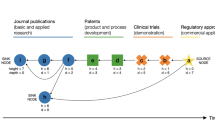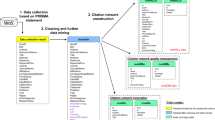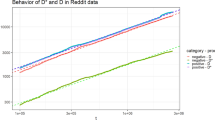Abstract
Prior studies have defined an effect of market entry order on commercial success that depends on attributes of the underlying technology, the rate of change in technology improvement, consumer expectations of these attributes and the degree of unmet demand. Analyses of pharmaceutical sales data suggest that the commercial success of drugs is subject to similar forces. These findings have important implications for innovation strategies.
This is a preview of subscription content, access via your institution
Access options
Subscribe to this journal
Receive 12 print issues and online access
$209.00 per year
only $17.42 per issue
Buy this article
- Purchase on Springer Link
- Instant access to full article PDF
Prices may be subject to local taxes which are calculated during checkout



Similar content being viewed by others
References
Boulding, W. & Christen, M. Sustainable pioneering advantage? Profit implications of market entry order. Marketing Sci. 22, 317–392 (2003).
Narasimhan, C. & Zhang, Z. J. Market entry strategy under firm heterogeneity and asymmetric payoffs. Marketing Sci. 19, 313–327 (2000).
Lieberman, M. B. & Montgomery, D. B. First-mover (dis)advantages: retrospective and link with the resource-based view. Strategic Management J. 19, 1111–1125 (1998).
Bohlmann, J. D., Golder, P. N. & Mitra, D. Deconstructing the pioneer's advantage: examining vintage effects and consumer valuations of quality and variety. Management Sci. 48, 1175–1195 (2002).
Gittleman, M., ten Raa, T. & Wolff, E. N. The vintage effect in TFP-growth: an analysis of the age structure of capital. National Bureau of Economic Research Working Paper No. 9768 (2003).
Carpenter, D. P. & Rynbrandt, R. T. Early entrant protection in U. S. pharmaceutical regulation. Harvard Working Paper [online] (2003).
Schmid, E. F. & Smith, D. A. Discovery, innovation and the cyclical nature of the pharmaceutical business. Drug Discov. Today 7, 563–568 (2002).
Fischer, M., Leeflang, P. S. H. & Wittink, D. R. Modelling the time to and height of peak sales for pharmaceutical brands. Working paper, University of Kiel (2005).
Shankar, V., Carpenter, G. S. & Lakshman, K. Late-mover advantage: how innovative late entrants outsell pioneers. J. Marketing Res. 35, 54–70 (1998).
Fischer, M., Shankar, V. & Clement, M. Does a sound international market entry strategy benefit late movers? Working paper, University of Kiel (2005).
Booth, B. L. & Zemmel, R. W. Quest for the best. Nature Rev. Drug Discov. 2, 838–841 (2003).
Nordmann, J. P. et al. Unoprostone monotherapy study group-EU. A double-masked randomized comparison of the efficacy and safety of unoprostone with timolol and betaxolol in patients with primary open-angle glaucoma including pseudoexfoliation glaucoma or ocular hypertension. 6 month data. Am. J. Ophthalmol. 133, 1–10 (2002).
Rosenberg, J. Head to head struggle: initial Celebrex, Vioxx ad spending, sales stunning. Advertising Age (03 April 2000).
Liebman, M. Head-to-head marketing: may the best promoted drug win. Medical Marketing & Media (01 November 2000).
Koerner, B. I. Disorders made to order: pharmaceutical companies have come up with a new strategy to market their drugs: first go out and find a new mental illness, then push the pills to cure it. Mother Jones (July–August 2002).
Levy, B. Consultant's report says 2004 will be pivotal in determining winners and losers in $6 billion ARB hypertension market. Business Wire (28 January 2004).
Winslow, R. Wonder drug: Sandoz Corp. 's Clozaril treats schizophrenia but can kill patients—and blood tests to prevent the lethal side effects are costly, controversial—who is going to pay $8,944? Wall Street J. pA1 (14 May 1990).
Loew, C. Stimulating innovation in medical technologies. HHS Public Meeting [online] (8 November 2004).
Cohen, F. Macro trends in pharmaceutical innovation. Nature Rev. Drug Discov. 4, 78–84 (2005).
Accenture & CMR International. Re-thinking innovation in pharmaceutical R&D. [online] (2005).
Ma, P. & Zemmel, R. Value of novelty? Nature Rev. Drug Discov. 1, 571–572 (2002).
DiMasi, J. A. & Paquette, C. The economics of follow-on drug research and development: trends in entry rates and the timing of development. Pharmacoeconomics 22 (Suppl. 2), 1–14 (2004).
Acknowledgements
The author wishes to thank Procter & Gamble Pharmaceuticals for its role in initiating and financially supporting the project that was the basis of this perspective; D. Fitzhenry, G. Glass and the anonymous reviewers for their insightful reviews of the manuscript; and M. Fischer for providing draft versions of his manuscripts.
Author information
Authors and Affiliations
Ethics declarations
Competing interests
Procter & Gamble Pharmaceuticals provided financial support for part of the research included in the manuscript.
Related links
Rights and permissions
About this article
Cite this article
Cohen, F. Entry order as a consideration for innovation strategies. Nat Rev Drug Discov 5, 285–294 (2006). https://doi.org/10.1038/nrd2009
Published:
Issue Date:
DOI: https://doi.org/10.1038/nrd2009
This article is cited by
-
Drug launch curves in the modern era
Nature Reviews Drug Discovery (2017)
-
Nation-scale adoption of new medicines by doctors: an application of the Bass diffusion model
BMC Health Services Research (2012)



